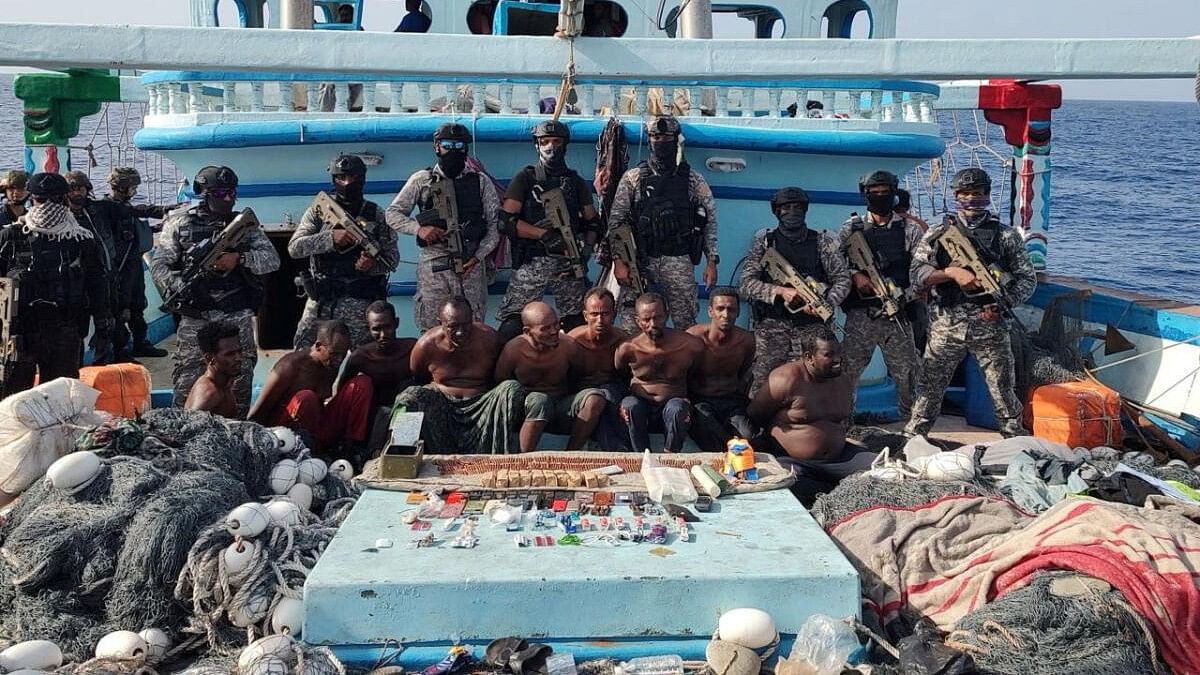
Members of the Indian Navy pose for a photo as they carried out a rescue operation of an Iranian fishing vessel Al-Kambar 786 after it was seized by armed pirates off Somalia, in the Arabian Sea
Credit: Reuters Photo
At first, they may appear like a string of disjointed maritime activities. But once the dots are connected, the half-a-dozen milestones the Indian Navy crossed in the last four months puts it in a renewed position of strength in the Indian Ocean region, in keeping with the strategic aspirations of a nation that is on its way to becoming the world’s third-largest economy.
The Indian Navy has completed over 100 days of intense maritime action on the western seaboard from the Strait of Bab-el-Mandeb and the eastern coast of Somalia to the Arabian Sea, responding to missile and drone attacks from suspected Houthi militants based in Yemen as well as countering several piracy attempts.
The blue water force has also commissioned its first squadron of MH-60R helicopters, opened a base at Minicoy island, operationalised new infrastructure at Karwar, despatched a Kalvari-class submarine for the first time to Campbell Bay at the mouth of the Malacca Strait, and deployed as many as 11 submarines and 35 warships simultaneously in a show of strength.
Taken together, all these activities reflect New Delhi’s growing maritime muscles even as China’s People’s Liberation Army Navy regularly criss-crosses the ocean using ports in friendly countries for quick turnaround. Naval sources said as many as six PLAN ships are often spotted in the Indian Ocean, along with multiple research and survey vessels. A fortnight ago, as many as 13 Chinese ships were sailing in the IOR.
“Nothing happens in the Bay of Bengal, the north Indian Ocean, and the Arabian Sea without the Indian Navy not knowing. In case of any requirement of intervention, we deploy accordingly,” Vice Admiral Biswajit Dasgupta (rtd), former Commander-in-Chief of the Eastern Naval Command told DH.
While vessels from the communist country are always on New Delhi’s radar, the world took note of the Indian Navy as a “world-class force” in the wake of its recent successes in anti-piracy missions, particularly the one involving MV Ruen. The Malta-flagged vessel was hijacked in December by Somali pirates, who converted it into a mother vessel to launch subsequent piracy strikes. In mid-March, the Indian forces led by destroyer INS Kolkata and supported by patrol craft INS Subhadra captured the pirates after a 40-hour-long operation on the high seas. The operation also involved an IAF C-17 dropping the marine commandos and their boats into the ocean for the soldiers to board the ship. The troops captured 35 pirates, freed 17 crews, and secured the cargo of 37,500 tonnes of steel plates. The bandits were brought for trials.
Days later in another anti-piracy operation east of Somalia, INS Sumedha and INS Trishul successfully rescued FV Al Kambar and its crew of 23 Pakistani nationals. All the nine pirates were apprehended and brought to India this week. Both batches of pirates were handed over to Mumbai Police for legal action as per the Maritime Anti-Piracy Act 2022.
“The anti-piracy operations will continue. We don’t have a time limit. The Indian Navy will take positive, proactive, and affirmative action to ensure the region is safe,” said Admiral R Hari Kumar, Chief of the Naval Staff.
Keeping the Arabian Sea safe and secure is essential to avoid a rise in the prices of essential commodities for India and other Asian nations. Nearly 57% of commercial cargo has already diverted their routes around the Cape of Good Hope bypassing the Suez Canal and Red Sea routes following the Israel-Palestine conflict and the excess cost is to be passed on to the customers.
Admiral Kumar said the freight insurance rate went up by 35-40% in the last few months and there were apprehensions on the promulgation of the High-Risk Area for the north Arabian Sea, further jacking up the shipping cost for commodities like crude, fertilizer, and finished goods.
New Delhi is taking such a proactive approach on the naval front, keeping its long-term aspirations in mind. No country can aspire to be a global power without being a maritime power and India -a regional force – harbours such an intention.
Besides the anti-piracy operations, Indian warships also provided assistance to the vessels hit by missiles and drones. The aid operation involved boarding the ship and dousing the onboard fire, sometimes amidst a challenging environment like in the case of MV Marlin Luanda, which was carrying 90,000 tonnes of naphtha.
Amidst the action, the navy commissioned a new base INS Jatayu at Minicoy, straddling the eight degree channel between Minicoy and Maldives, and the nine degree channel between Minicoy and the main cluster of Lakshadweep island. The base will have its own airfield and can serve as an operational turnaround point for naval ships and aircraft extending their surveillance range. This will help to keep an eye on the EEZ of other smaller nations that don’t have the capacity.
Days later, the eastern naval command sent a Kalvari class submarine to Campbell Bay, which is 145 km north of Indonesia and overlooks the six degree channel between the Great Nicobar Island and Sumatra.
New US-made helicopters have come to boost the combat readiness of destroyers and frigates. Additional infrastructure including a 75-meter-tall covered dry berth to park four capital ships is ready at Karwar-based naval base, INS Kadamba, which on completion will become the biggest naval base east of the Suez canal housing more than 50 warships and submarines.
The two aircraft carriers are operational, and the navy has petitioned the government for a third one. All are telltale signs of India flexing its naval power as competition with China grows.
“We are the biggest navy in the region and will have to play a role as there are a lot of expectations from us. We are trying to meet our national goals,” summed up Vice Admiral Dasgupta.
